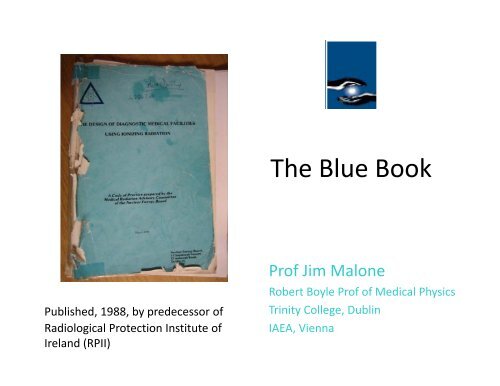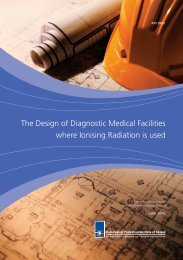Blue Book - Radiation Shielding for Medical Instalations
Blue Book - Radiation Shielding for Medical Instalations
Blue Book - Radiation Shielding for Medical Instalations
Create successful ePaper yourself
Turn your PDF publications into a flip-book with our unique Google optimized e-Paper software.
The <strong>Blue</strong> <strong>Book</strong><br />
Published, 1988, by predecessor of<br />
Radiological Protection Institute of<br />
Ireland (RPII)<br />
Prof fJim Ml Malone<br />
Robert Boyle Prof of <strong>Medical</strong> Physics<br />
Trinity College, g, Dublin<br />
IAEA, Vienna
Problems with <strong>Blue</strong> <strong>Book</strong><br />
• Changes in Legislation,<br />
Technology, Clinical Practice,<br />
Building Style, Building<br />
Materials<br />
• Changes in Dose Limits and<br />
Constraints<br />
• Use of Upper Floors<br />
• Need illustrated floor plans<br />
• Advice on Ceilings,<br />
• Higher levels of walls<br />
• Practical Tips and Solutions<br />
• OBJECTIVES<br />
• Preference <strong>for</strong><br />
comprehensive local<br />
l<br />
solution<br />
• Not to innovate, but<br />
to produce a reliable<br />
practical manual or<br />
code.
Issues, 1: Equipment
Issues 2: New Problems<br />
• Ward walls not solid<br />
• Theatre workloads not<br />
consistent with modern<br />
practice.<br />
• Other – recovery rooms,<br />
endo suites, lithotripsy,<br />
cardiac pacing<br />
• Radionuclides in Theatres<br />
• PET shielding
Issues 3: Dose Constraints<br />
Category of<br />
Personnel<br />
Dose<br />
Constraint<br />
t<br />
1998<br />
mSv/year<br />
Dose<br />
Constraint<br />
t<br />
2001<br />
mSv/year<br />
Exposed<br />
50 5.0 10 1.0<br />
Worker<br />
All others 0.05 - 1.0 0.3
Issues 4: <strong>Medical</strong> Physics<br />
<strong>Medical</strong> Physics Support<br />
• Deficits in numbers, leadership and<br />
academic involvement/connectivity<br />
i i<br />
• Often poor, or inadequate training, and<br />
narrow or inadequate experience<br />
• Risk of litigation and difficulties with public<br />
accountability
Design Code (2 nd edition)<br />
• About 100<br />
pages incl.<br />
Appendices<br />
1. Legal and Administrative<br />
Framework<br />
2. <strong>Radiation</strong> Protection, Project<br />
Management and Building<br />
Projects<br />
3. Rdil Radiology Room Design and<br />
Layout<br />
4. Nuclear Medicine<br />
5. <strong>Shielding</strong> Calculations<br />
6. Some Practical Considerations<br />
www.rpii.ie<br />
RPII, 3 Clonskeagh Square, Dublin 14, Ireland
1. Statutory Framework<br />
• The Radiological Protection Act, 1991 (Ionising<br />
<strong>Radiation</strong>) Order 2000 (SI No. 125 of 2000)<br />
• European Communities (<strong>Medical</strong> Ionising i Rditi <strong>Radiation</strong><br />
Protection) Regulations 2002, 2007 (SI. No. 478 of<br />
2002 & SI. No. 303 of 2007)<br />
• RPII Licensing System and Requirements<br />
• Related EU Directives
2. <strong>Radiation</strong> Protection, Project<br />
Management and Building Projects<br />
• The <strong>Radiation</strong> Safety Committee<br />
• The <strong>Radiation</strong> Protection Advisor<br />
• Project Teams, New Building Design Cycle,<br />
Refitting Buildings<br />
• Dose Limits and Dose Constraints<br />
• Risk Assessments<br />
• Site visits essential<br />
Issue of New Build versus Conversion/Refit
Radiology Room Design and Layout<br />
• Radiology Room<br />
Types<br />
• General Comments on<br />
<strong>Shielding</strong><br />
• Radiography Rooms<br />
– General<br />
– Chest Room<br />
– Mammography<br />
– DXA<br />
– Dental<br />
• Fluoroscopy Rooms<br />
– General Fluoroscopy<br />
– Interventional<br />
Radiology and<br />
Cardiology<br />
• CT<br />
• Shared Function<br />
Rooms (A&E, Theatres,<br />
wards)<br />
• Equipment in Trailers
3. Radiology Room Design and Layout<br />
General Radiology<br />
• Two-corridor Design<br />
• Large enough <strong>for</strong> trolleys, table and<br />
chest radiology<br />
• Typical room sizes given<br />
• Generally 2mm Lead – assess on<br />
individual basis<br />
• Primary Beam absorber<br />
• Staff entrance behind protective screen<br />
• Typical screen lengths presented<br />
• Chest stand positioned to minimise<br />
scatter entering protective ti console<br />
• Changing cubicles<br />
Specific Requirements <strong>for</strong> each type of facility<br />
Examples of Good Layouts
3. Radiology Room Design and Layout<br />
Dental Surgery<br />
No shielding required if: < 20 exps/wk<br />
and 2m between patient and all boundaries<br />
CT<br />
Separate staff area – Other staff present<br />
Need good view of door and patient<br />
Scanner angled <strong>for</strong> access and visibility<br />
MSCT: 3-4mm Pb
DXA and CT
Design Criteria<br />
ia<br />
Corrido<br />
Corridor<br />
Corridor
9/3/2009
Mobile X‐Ray Equipment
Equipment not in Rooms
Equipment not in Rooms
Equipment not even in Building<br />
• Re‐shielding often<br />
means complete refit<br />
• Hospital can’t do<br />
without equipment <strong>for</strong><br />
6 months<br />
• Trailer arrives ‐‐‐‐‐<br />
• Trailer
5. <strong>Shielding</strong> Calculations<br />
X‐Ray<br />
• Review of two widely used<br />
<strong>Shielding</strong> Methodologies<br />
– BIR, 2000<br />
– NCRP, 2004<br />
• Variables<br />
– Distance from Barrier<br />
– Workload<br />
– Occupancy<br />
• BIR: Workload is based (ESD) and<br />
(DAP)<br />
• NCRP: Workload based on “beam‐<br />
on” time. in mA min per week<br />
Issue of New Build versus Conversion/Refit
Workload
Workload<br />
• Either DAP (BIR) or mA‐min/week min/week (NCRP)<br />
• Try and base figures on real audit/projection<br />
• Historical i or published data can mislead il • If no other option, use published data<br />
• Transparency and accountability to the public<br />
• Defendable legally (reasonable patient, not reasonable doctor)
Occupancy
Occupancy<br />
• Occupancy of adjoining areas to be assessed<br />
• Try and get real in<strong>for</strong>mation<br />
• Consider rooms on other side of corridor<br />
• Extremes: Office, 100%; Unattended carpark,<br />
2.5 to 5 %<br />
• Reservation about NCRP door value in new<br />
builds, and Remember:<br />
• Transparency and accountability to the public<br />
• Defendable legally (reasonable patient, not reasonable doctor)
General Radiographic Room<br />
Ceiling (BIR method)
General Radiographic Room<br />
Ceiling (NCRP method)<br />
General Rm Window, scatter only, at 10 m
6. Practical Considerations<br />
• Building Materials<br />
– Lead sheet and lead<br />
products<br />
– Concrete and concrete<br />
Blocks<br />
– Barium Plaster<br />
– Brick<br />
– Gypsum Wallboard<br />
– Lead Glass<br />
– Lead Acrylic<br />
• Walls<br />
• Floors and Ceilings<br />
• Doors<br />
• Windows<br />
• Staff Areas<br />
• Joints, Services, Openings<br />
and Per<strong>for</strong>ations<br />
• Assessment of <strong>Shielding</strong><br />
• Nuclear Medicine<br />
ALWAYS NEED TO VISIT AND SEE IMPLEMENTATION
9/3/2009
Lead Codes<br />
Code No. 3 4 5 6 7 8<br />
Nominal Thickness (mm)<br />
1.32 1.80 2.24 2.65 3.15 3.55<br />
Weight (kgm ‐2 ) 14.6 19.5 24.44 29.3 34.2 39.1<br />
Cost (Relative)<br />
• When installed as part of a new build, lead is not<br />
very dear relative to other costs
Some Data 2:
Some Data Figure C 6<br />
• Also f room; Some Data Table C2<br />
Also f room; Some Data Table C2<br />
and C3,4,or Fig C6 and page 101
• Advice <strong>for</strong> imaging<br />
facilities located on<br />
upper floors<br />
Issues<br />
• Advice <strong>for</strong> shielding of<br />
windows on upper<br />
floors<br />
• Transparent,<br />
• Accountable<br />
• Defendable
CONCLUSION<br />
www.rpii.ie<br />
RPII<br />
3 Clonskeagh Square,<br />
Dublin 14<br />
Ireland
















